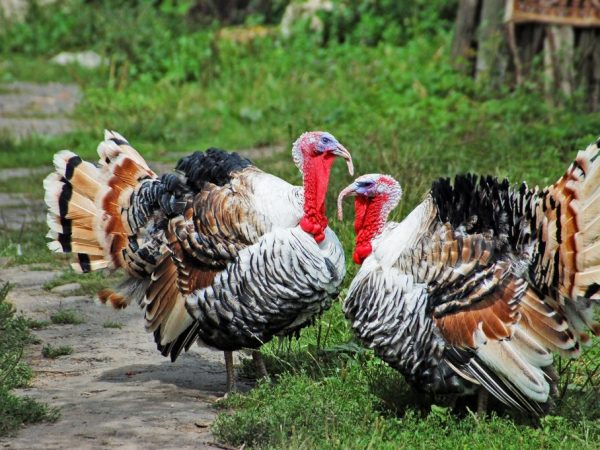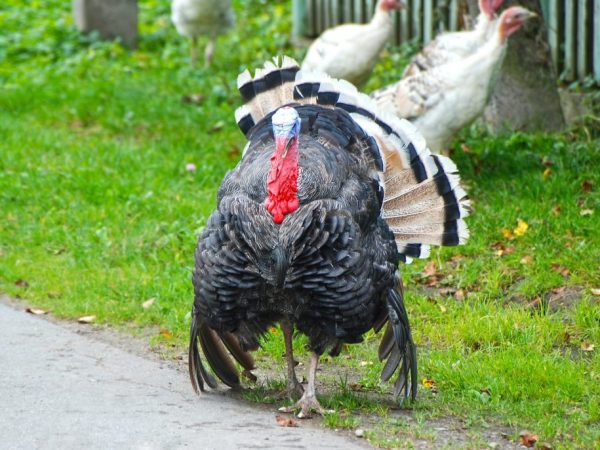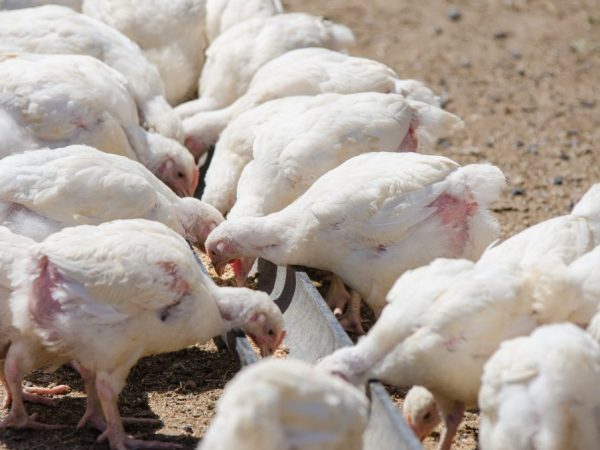Breeding and raising broiler turkeys
Very often, on the shelves in stores, we see the inscription "broiler" on chicken or turkey meat. Many inexperienced buyers think that this is some kind of non-natural meat. In fact, broiler turkeys are the same meat as regular farm turkeys, only raised for the purpose of obtaining meat. Usually, broiler meat tastes much better than regular meat, as it is softer, juicier and even more attractive. In appearance, live birds are no different, but the care, maintenance and conditions for growing them at home are different.

Breeding and raising broiler turkeys
Breeding and raising broiler turkeys The most popular breed among farmers is the French broiler large turkey and big variety... In some cases, the weight of an adult can reach from 4.5 kg to 35 kg, depending on how the bird grows, and it also depends on the breed. The broad-breasted broiler male looks beautiful and has a good weight. Purchase birds for growing for meat it is possible from breeders or from hands through buy - sell ads. On various sites and forums, you can find many offers for the sale of turkeys.
For cutting broilers, many farmers use the cone system. Turkey of any breed before slaughter can go for meat after a month, but mostly grown for a longer period, to get more eggs. Some farmers raise and keep birds of any breed only for sale. In this case, the sale is carried out strictly through the registration of the type of activity and the passage of veterinary examinations and analyzes. Before deciding what you need to breed and keep turkeys for, you need to read the description, see photos and videos of each breed.
Features of growing turkeys
In fact, broiler turkeys at home are demanding birds, especially in terms of heat. To raise good, healthy broiler turkeys for slaughter, the temperature must be at least 20 degrees. It is for this reason that litter is required on the floor of the turkey house. Most often it is hay, sometimes straw, sawdust and other materials are used. Turkeys are afraid of drafts, but this does not mean that in a turkey house there should be no windows and ventilation systems. On the contrary, the ventilation system must be carefully thought out, taking into account this particular feature of the bird. Growing broiler turkeys at home should be divided into breeds that need a lot of light for normal growth and development, so you should not save on windows.
As very proud and important, broiler turkeys like it when everyone has free space, personal space, so build a large turkey house. On average, one broiler needs at least 1 square meter. And if you keep not only turkeys, but also turkeys, then know that only 4-5 turkeys are relied on for 40 females, otherwise a fight simply cannot be avoided.Growing broiler turkeys is carried out in the best way, like any bird, turkeys may have infections, therefore, individuals need to be kept clean at home. Before each new "settlement" the turkey poultry must be disinfected and thoroughly washed. But the litter needs to be changed much more often.
Walking for the health of turkey poults
If it so happens that your turkey poultry is not very large, then you definitely need to make sure that your broiler turkeys and their cultivation are carried out taking into account all the requirements. It is necessary that individuals have a place for walking. Regardless of the breed of broiler turkeys, this is very necessary for their health, since birds that move little often have obesity, which will negatively affect the quality of meat, respectively, and on your wallet.
In addition, walking turkeys can also save a lot on feed. After all, it is very easy to plant perennial grasses in the place of walking. It can be clover or alfalfa. And if there is a lot of room for walking, then you can plant annuals. For example, peas, oats and others. The advantages of such a walk will also be that your birds will receive all the necessary vitamins and minerals from green plants.
You can walk a broiler turkey not only in summer. If the winter was not very cold and frosty, then broiler turkeys can walk perfectly. But there are conditions. The walking area should be covered with bedding, hay, straw or sawdust. It is also recommended to install a canopy over the pasture not only in winter, but also in summer. This will protect the turkeys from precipitation, extreme heat and wind. There are birds that simply do not want to leave the turkey poultry in winter. In this case, it is worth pouring a thin path of grain onto the street and the bird, absorbing the grain, will calmly go out into the street. It is also worth taking care of a high and reliable fencing of the walking area, since the turkey can safely climb if the fence is too low and run away.
Perches in a turkey house

Turkeys love to perch
At home, broiler turkeys do not sleep on a litter. To do this, they use special sticks, under the name perches... It is best to install them away from the exit, in the far corner, in order to avoid drafts. They are usually set up like the rows in a movie theater - one higher than the other. The recommended distance between the rows is 50 cm. The first row is made at a level of 80 cm from the floor. But guessing how many perches you need is very simple. One turkey needs about 0.45 meters.
Of course, the sticks must be thick, because they will have to withstand the weight of not one or two turkeys. To avoid injury, the perches are made smooth, without splinters and with rounded ends. Also, in this case, you can improve and cleaning. You've probably seen pallets in parrot cages. This system can be applied here as well. This will save cleaning time and keep the poultry house relatively clean.
Turkey nests
How to raise broiler turkeys at home? Since the main task for broilers is meat and turkeys are slaughtered at reproductive age, in this case nests are not needed. But if you plan to grow and breed broilers yourself, then equip nests have to. After all, turkeys also lay eggs. Nests are made according to the principle, like the turkey poultry itself. The location should be calm and quiet.
The total size of a nest for 6 turkeys should be at least 60 x 60 cm. Nests should be checked. It should be littered and cleaned frequently to avoid the development of infections. There are various types of nests. It can be both single, designed for one laying hen, and turkey poultry areas. If there is no desire, but there is an opportunity, then such a nest can be purchased in the store.
Equipment for organizing bird feeding
To keep your broiler turkeys healthy, they need not only quality feed, but also equipment from which your indoor broilers can eat and drink.
There are several rules for choosing such equipment.
- All feeders should not pose a threat to the life and health of the turkey.
- For small broiler turkeys, it is best to choose soft feeders to avoid damaging the beak.
- It is not recommended to use galvanized and aluminum troughs for products that are oxidized.
- Broiler turkeys at home love free space, so even make feeders free.
- Each type of food has its own type of feeder, so do not skimp on this.
- The installation level should be comfortable for the turkey. This is usually the height at the level of the bird's back.
- Feeder design must be strong. Since an unstable structure, broiler turkeys can simply turn over.
Experts note that the best drinker is the nipple
- The water in the nipple drinker is not subject to stagnation.
- All individuals drink as much water as they need.
- It is almost impossible to pour water to broiler turkeys from such a drinking bowl.
For drinkers, the rule is that each turkey should have a lot of free space. If you have installed ordinary drinkers, especially those made by yourself, you need to often check the presence and purity of water in them. If the drinker is heavy, it must be secured to avoid injury to the birds.
Turkey nutrition

We observe the diet
Eating a balanced diet is the key to success. Breeding healthy and fleshy birds is possible only if the prescribed diet is observed. Each type and breed of turkeys has its own nutritional features... Growing broiler turkeys at home has nutrition schemes that are universal and suitable for almost everyone.
- It is worth feeding broiler turkeys every two hours.
- Chicks are given all food crushed, for example, a mash of different types of cereals, alternating with different greens - grated carrots and other finely chopped herbs.
- All feed must be fresh and of good quality. Do not cook it long before feeding. On average, it is cooked 15-20 minutes before feeding.
- It is necessary to feed, especially a young broiler turkey, 4 times a day.
- Food should contain sufficient amounts of vitamins and minerals.
- In winter, they give top dressing. Indobrollers consume chalk, fish oil and shells.
- Meals should be portioned to avoid obesity and disease.
The turkey is one of the largest secular birds. That is why the water intake of turkeys is much more than that of chicken, for example. The water must be of high quality, fresh and clean. Small farms are considered to be the ideal environment for turkey poultry, as almost every bird can be cared for, cared for and cared for. If all of the above tips and tricks are followed, then keeping turkeys will not take much time and you will have wonderful birds.
Taking proper care of turkeys
Your turkey needs to be cared for and cared for to keep it healthy and its meat and eggs are of the highest quality.
Basic rules of care
- From the first month, it is important to maintain the room temperature.
- Feeding should be balanced and correct.
- Lots of light during the day and artificial lighting at night.
- No drafts and low humidity levels.
- Obligatory, both summer and winter walks.
- Timely prevention of infections.
- Compliance with the dimensions of the turkey house and nests.
- When coccidiosis and similar problems occur, veterinarians prescribe amprolium.
Unfortunately, at home turkeys are very vulnerable to parasites. These include ticks, fleas, bedbugs and others. These parasites live both on the body and on the feathers of birds.
There are a number of indications for determining the presence of parasites in turkeys.
- The bird begins to scratch very intensely.
- After infection with helminths, appetite disappears.
- When looking at turkey fur, you can see the parasites visually.
You need to be very careful about the presence of these symptoms, since the parasites are very quickly and easily transmitted from one turkey to another.
Preventive measures
Breeding and keeping such birds implies preventive measures against various diseases. If you follow fairly simple rules of prevention, you can easily avoid problems and maintain the health of individuals.
- The simplest and most painless is to carry out a visual inspection from time to time. Crossbred broilers or large specimens need constant attention. Of course, you simply cannot physically inspect all the livestock. Usually turkeys are taken from different sides. Not all parasites are visible to the naked eye, so at least the lighting should be sufficient. Typically, parasites target the head, legs, and anus, so special attention should be paid to these parts.
- Some parasites that drink blood settle in dust and bedding. From infection with such parasites, the weight of individuals is significantly reduced. That is why the litter should be changed more often. To inspect the litter for such parasites, place it on a white sheet of paper. Since the parasites are mostly black, they will be clearly visible.
- Also, there are types of parasites that attack at night. Accordingly, inspection or breeding should then be carried out in the evening.
- Like any bird, turkeys can cleanse themselves to a certain extent. To do this, in a turkey house, or at the place of walking, you need to install a container with sand, half with ash.
How to avoid escaping turkey poultry?
It is worth remembering that turkeys are also birds, especially domestic ones, with wings. If you want the keeping and breeding of birds to become easy and convenient, then you need to take care of the safety of the livestock. In the presence of wings, individuals are able to fly. Their flight speed can reach 20 km / h, so if it does fly away, it is very unlikely that you will return it, or it will return itself. There are species that can reach speeds even up to 90 km / h.
To avoid unwanted flights and escapes, you can take the following measures
- Undercutting the wing feathers.
- You can artificially connect the wings, for example, tie them with a rope.
- If these are turkeys, then they can cauterize their wings.
- The simplest thing is to fence off the walking area from all sides. In such cases, a dense mesh is pulled from above.


